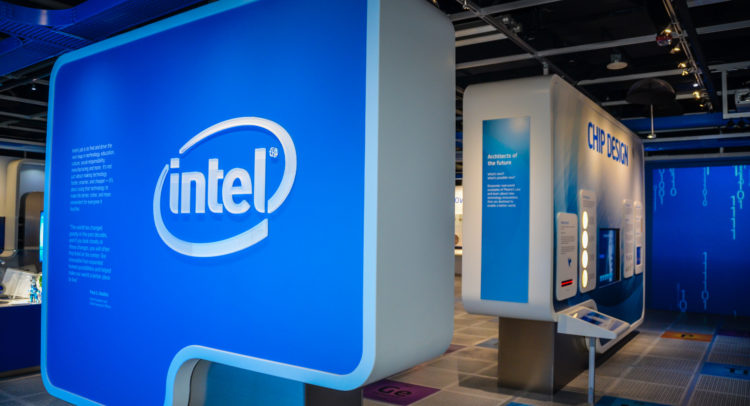America’s chipmakers are under a great deal of pressure in the 2020s as supply-chain bottlenecks have created an acute tech-component shortage. It’s risen to crisis-level trouble because the demand is still there, yet companies like Intel just can’t provide the supply.
Invest with Confidence:
- Follow TipRanks' Top Wall Street Analysts to uncover their success rate and average return.
- Join thousands of data-driven investors – Build your Smart Portfolio for personalized insights.
Headquartered in Santa Clara, California, Intel Corporation (INTC) is among the largest microprocessor designers and manufacturers in the world. I am bullish on the stock.
Intel’s first-quarter 2022 financial results were closely watched as they represented a bellwether for the microprocessor industry in general. If Intel fails, it’s a bad omen for the rest as the company is a major competitor in the global chipmaker market.
Judging by the price action of INTC shares immediately after releasing its quarterly earnings data, investors might be tempted to assume that the company is in poor shape. Granted, Intel is facing the same supply-chain problems that are causing issues for many technology-component manufacturers.
Evaluating Intel’s fiscal status solely based on the superficial sentiment would be a mistake, however. Informed investors must get into the habit of looking under the hood and analyzing the actual results – which, in Intel’s case, actually aren’t too disappointing.
Exceeding (Some) Expectations
Were Intel’s first-quarter 2022 results a beat or a miss? The answer depends on whom you’re asking.
Of course, if you ask Intel, the results were across-the-board beats. However, we need to bear in mind that the purpose of a corporate press release isn’t to highlight the negative data points.
Still, it’s irrefutable that Intel exceeded its expectations “on both the top- and bottom-line,” as Pat Gelsinger, the company’s CEO, put it. Starting with the top-line results, Intel posted first-quarter 2022 GAAP revenue of $18.4 billion, down 7% year-over-year. Coincidentally, the company’s non-GAAP revenue also totaled $18.4 billion, and that figure represented a 1% year-over-year decline.
Revenue declines aren’t typically good news, but both of those numbers exceeded Intel’s guidance provided back in January. Furthermore, Intel achieved company-record quarterly revenue in the company’s Network and Edge Group, Mobileye, and Foundry Services businesses.
In other words, Intel’s top-line results were just fine, according to Intel. They were also in line with Wall Street’s expectations, as analysts had anticipated that the chipmaker would achieve $18.3 billion in quarterly revenue.
Moreover, Intel beat its own expectations, as well as those of Wall Street, in terms of the company’s Q1 2022 top-line results. As it turned out, Intel’s non-GAAP earnings per share (EPS) was 87 cents, exceeding Intel’s January guidance by 7 cents and beating the analyst community’s consensus estimate of 78 cents.
A Strong Start?
With the aforementioned fiscal figures in mind, Gelsinger declared that Intel had “a strong start to the year.” Granted, the beats (or at least meets) on the top and bottom lines support a fairly firm bullish case for INTC stock in 2022.
Not everyone is impressed with Intel at the moment, though, and this sense of disappointment is reflected in the sharp, negative price action of INTC stock. What’s the sticking point that prompted a share-price decline, then?
When a company posts beats and/or in-line financial results but the stock price sells off anyway, oftentimes there’s one clear culprit: guidance. It’s not unusual for investors to panic-sell their shares when they’re not happy with a company’s future fiscal outlook.
“[W]e are reaffirming our full-year revenue guidance,” Intel CFO David Zinsner declared – which might sound fine, but it’s not what some investors apparently wanted to hear.
Specifically, Intel maintained a Q2 2022 revenue outlook (both GAAP and non-GAAP) of $18 billion. Perhaps Intel’s investors were hoping for a higher figure than that.
Reportedly, the analyst consensus call was for a second-quarter 2022 revenue outlook $18.3 billion. Therefore, Intel’s $18 billion outlook was a “miss” compared to what Wall Street envisioned.
Let’s be sensible here, though. $18 billion, compared to $18.3 billion, isn’t a horrendous shortfall. Besides, this wasn’t an actual “miss” in terms of what actually happened. It only represents what Intel anticipates will happen during the current quarter.
If this was the reason why people dumped their INTC stock shares, then there’s a huge buying opportunity to be capitalized on. After all, Intel’s trailing 12-month price-to-earnings ratio of 9.13 suggests that the stock is a major bargain for value-focused investors now.
By the way, Intel is also paying a forward annual dividend yield of 3.21%, an icing on the cake for INTC stockholders.
Wall Street’s Take

According to TipRanks’ analyst rating consensus, INTC is a Hold, based on six Buy, 13 Hold, and seven Sell ratings. The average Intel price target is $51.10, implying a 17.23% upside potential.
The Takeaway
Intel’s actual financial results weren’t particularly bearish, but some investors still found a cause for panic. In this instance, it was all about Intel’s forward guidance, which was only slightly below Wall Street’s expectations.
Investors should consider starting or adding to their INTC stock positions because the initial response to Intel’s financial report wasn’t entirely reasonable. It’s a great example of how you can invest sensibly even when the markets aren’t being entirely sensible.
Discover new investment ideas with data you can trust
Read full Disclaimer & Disclosure









